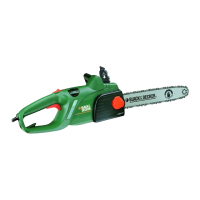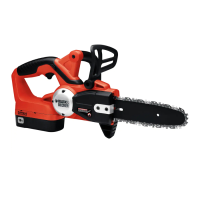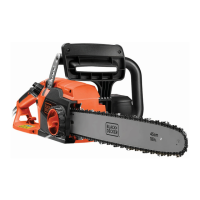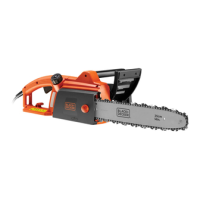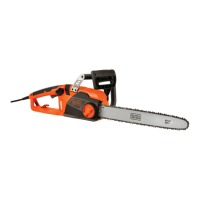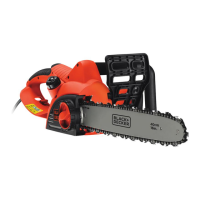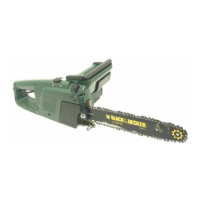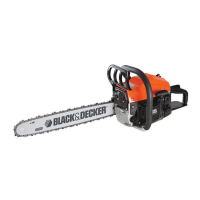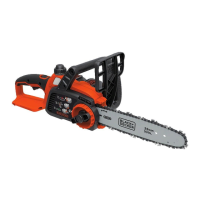Do you have a question about the Black & Decker Chain Saw and is the answer not in the manual?
Keep work area clean, avoid explosive atmospheres, and keep children away.
Match plugs, avoid earthed surfaces, keep dry, don't abuse the cord, use outdoor extension cords.
Stay alert, use safety equipment, avoid accidental starting, remove keys, don't overreach, dress properly.
Don't force the tool, check switch, disconnect before adjustments, store properly, maintain tools, keep sharp, use as intended.
Keep body parts away from the moving saw chain and ensure it's not contacting anything.
Always hold the chainsaw with right hand on rear handle and left on front handle.
Wear safety glasses, hearing protection, and other adequate protective clothing.
Do not operate a chainsaw while up in a tree.
Always maintain proper footing and operate on a secure, level surface.
Be alert for spring back when cutting tensioned limbs.
Use caution when cutting brush/saplings as they can catch the chain.
Carry chainsaw switched off, away from body, with guide bar cover fitted.
Follow instructions for lubrication and chain tensioning for optimal performance.
Keep handles dry, clean, and free from oil/grease to prevent loss of control.
Use the chainsaw only for cutting wood, not for other materials.
Kickback occurs when the guide bar tip touches objects or wood pinches the chain.
Maintain a firm grip and position body/arms to resist kickback forces.
Avoid overreaching and cutting above shoulder height to maintain control.
Use only manufacturer-specified guide bars and chains to prevent kickback.
Follow sharpening and maintenance instructions to avoid increased kickback.
First-time users should get practical instruction from experienced users.
Ensure the brake is engaged when carrying the chainsaw.
Maintain chainsaw when not in use; store parts separately if stored long term.
Avoid cutting into ground, wire fences, nails, brush, saplings, or above shoulder height.
Explanation of warning symbols found on the tool.
Tool is double insulated, check power supply, use RCD for enhanced safety.
Not for unsupervised young/infirm persons, child supervision, cord replacement by authorized personnel.
Soak new chains in oil for at least an hour before first use.
Step-by-step guide for fitting the guide bar and chain, ensuring correct alignment and tension.
Check chain tension before use and every 10 minutes; adjust for 3mm clearance.
Fill the oil reservoir with recommended chain oil and check the level indicator.
The chain brake stops the chain within 150ms upon trigger release or kickback.
Pull the front guard/chain brake assembly back to the "set" position.
Describes how the chain brake activates during kickback.
Describes how the chain brake activates via inertia during severe kickback.
Instructions on how to test the chain brake functionality.
Steps to safely start the chainsaw using the lock-off and on/off switches.
Steps to take if the saw chain or guide bar becomes jammed.
Inexperienced users should not attempt to fell trees due to potential risks.
Maintain a safe distance from bystanders, buildings, and objects during felling.
Check local regulations and consider factors affecting fall direction before felling.
Consider tree lean, limb structure, obstacles, and wind for planned fall direction.
Pre-plan and clear an exit route before felling trees or branches.
Do not fell trees with a diameter greater than the chainsaw's cutting length.
Cut a direction notch to guide the tree's fall direction.
Make a horizontal felling cut 1-2 inches above the direction notch.
Use wedges in the felling cut to control the tree's drop.
Check local regulations and be aware of risks like chain pinching and kickback.
Consider branch weight, limb structure, obstacles, and wind before pruning.
Consider limb access, fall direction, and risks to people/property below.
Use an upward cut for one-third depth, then a downward cut to avoid splintering.
Adjust cutting method based on how the log is supported (e.g., saw horse).
Make a downward cut, avoiding the earth to prevent blunting the chain.
Cut one-third down, then cut again to meet the first cut to avoid splintering.
Make an upward cut for one-third depth, then a downward cut to prevent splintering.
Always stand on the uphill side when cutting on a slope.
Use a saw horse for stable support, cutting on the outside of the arms.
Secure logs on the ground with chocks/wedges, ensure chain doesn't contact ground.
Regular maintenance ensures a long and effective life for the tool.
Ensure the oil reservoir level does not fall below a quarter full.
Clean chain and guide bar after use, turn guide bar 180 degrees for even wear.
Keep saw chain teeth sharp for best performance; use a sharpener kit.
Genuine spare parts are available from retailers or service agents.
Chain cutters blunt quickly if they touch the ground or nails.
Regularly check and adjust the saw chain tension.
Repairs should only be carried out by qualified personnel using original parts.
Instructions for safely replacing the mains plug.
Proper disposal and recycling of used tools and packaging.
Specifications for different Black & Decker chainsaw models.
Declaration of compliance with EU directives and standards.
Information on the Black & Decker product guarantee.
Keep work area clean, avoid explosive atmospheres, and keep children away.
Match plugs, avoid earthed surfaces, keep dry, don't abuse the cord, use outdoor extension cords.
Stay alert, use safety equipment, avoid accidental starting, remove keys, don't overreach, dress properly.
Don't force the tool, check switch, disconnect before adjustments, store properly, maintain tools, keep sharp, use as intended.
Keep body parts away from the moving saw chain and ensure it's not contacting anything.
Always hold the chainsaw with right hand on rear handle and left on front handle.
Wear safety glasses, hearing protection, and other adequate protective clothing.
Do not operate a chainsaw while up in a tree.
Always maintain proper footing and operate on a secure, level surface.
Be alert for spring back when cutting tensioned limbs.
Use caution when cutting brush/saplings as they can catch the chain.
Carry chainsaw switched off, away from body, with guide bar cover fitted.
Follow instructions for lubrication and chain tensioning for optimal performance.
Keep handles dry, clean, and free from oil/grease to prevent loss of control.
Use the chainsaw only for cutting wood, not for other materials.
Kickback occurs when the guide bar tip touches objects or wood pinches the chain.
Maintain a firm grip and position body/arms to resist kickback forces.
Avoid overreaching and cutting above shoulder height to maintain control.
Use only manufacturer-specified guide bars and chains to prevent kickback.
Follow sharpening and maintenance instructions to avoid increased kickback.
First-time users should get practical instruction from experienced users.
Ensure the brake is engaged when carrying the chainsaw.
Maintain chainsaw when not in use; store parts separately if stored long term.
Avoid cutting into ground, wire fences, nails, brush, saplings, or above shoulder height.
Explanation of warning symbols found on the tool.
Tool is double insulated, check power supply, use RCD for enhanced safety.
Not for unsupervised young/infirm persons, child supervision, cord replacement by authorized personnel.
Soak new chains in oil for at least an hour before first use.
Step-by-step guide for fitting the guide bar and chain, ensuring correct alignment and tension.
Check chain tension before use and every 10 minutes; adjust for 3mm clearance.
Fill the oil reservoir with recommended chain oil and check the level indicator.
The chain brake stops the chain within 150ms upon trigger release or kickback.
Pull the front guard/chain brake assembly back to the "set" position.
Describes how the chain brake activates during kickback.
Describes how the chain brake activates via inertia during severe kickback.
Instructions on how to test the chain brake functionality.
Steps to safely start the chainsaw using the lock-off and on/off switches.
Steps to take if the saw chain or guide bar becomes jammed.
Inexperienced users should not attempt to fell trees due to potential risks.
Maintain a safe distance from bystanders, buildings, and objects during felling.
Check local regulations and consider factors affecting fall direction before felling.
Consider tree lean, limb structure, obstacles, and wind for planned fall direction.
Pre-plan and clear an exit route before felling trees or branches.
Do not fell trees with a diameter greater than the chainsaw's cutting length.
Cut a direction notch to guide the tree's fall direction.
Make a horizontal felling cut 1-2 inches above the direction notch.
Use wedges in the felling cut to control the tree's drop.
Check local regulations and be aware of risks like chain pinching and kickback.
Consider branch weight, limb structure, obstacles, and wind before pruning.
Consider limb access, fall direction, and risks to people/property below.
Use an upward cut for one-third depth, then a downward cut to avoid splintering.
Adjust cutting method based on how the log is supported (e.g., saw horse).
Make a downward cut, avoiding the earth to prevent blunting the chain.
Cut one-third down, then cut again to meet the first cut to avoid splintering.
Make an upward cut for one-third depth, then a downward cut to prevent splintering.
Always stand on the uphill side when cutting on a slope.
Use a saw horse for stable support, cutting on the outside of the arms.
Secure logs on the ground with chocks/wedges, ensure chain doesn't contact ground.
Regular maintenance ensures a long and effective life for the tool.
Ensure the oil reservoir level does not fall below a quarter full.
Clean chain and guide bar after use, turn guide bar 180 degrees for even wear.
Keep saw chain teeth sharp for best performance; use a sharpener kit.
Genuine spare parts are available from retailers or service agents.
Chain cutters blunt quickly if they touch the ground or nails.
Regularly check and adjust the saw chain tension.
Repairs should only be carried out by qualified personnel using original parts.
Instructions for safely replacing the mains plug.
Proper disposal and recycling of used tools and packaging.
Specifications for different Black & Decker chainsaw models.
Declaration of compliance with EU directives and standards.
Information on the Black & Decker product guarantee.
| Brand | Black & Decker |
|---|---|
| Model | Chain Saw |
| Category | Chainsaw |
| Language | English |
